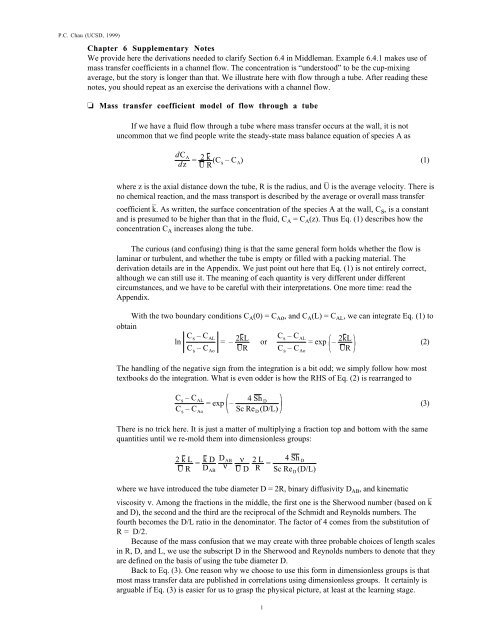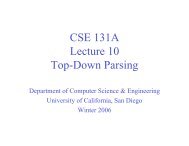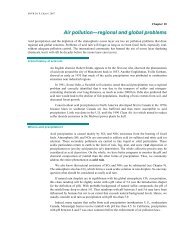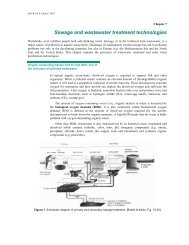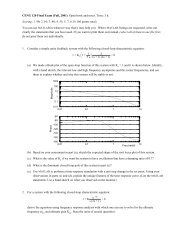Miscellaneous notes on mass transfer coefficient models
Miscellaneous notes on mass transfer coefficient models
Miscellaneous notes on mass transfer coefficient models
Create successful ePaper yourself
Turn your PDF publications into a flip-book with our unique Google optimized e-Paper software.
P.C. Chau (UCSD, 1999)<br />
Chapter 6 Supplementary Notes<br />
We provide here the derivati<strong>on</strong>s needed to clarify Secti<strong>on</strong> 6.4 in Middleman. Example 6.4.1 makes use of<br />
<strong>mass</strong> <strong>transfer</strong> <strong>coefficient</strong>s in a channel flow. The c<strong>on</strong>centrati<strong>on</strong> is “understood” to be the cup-mixing<br />
average, but the story is l<strong>on</strong>ger than that. We illustrate here with flow through a tube. After reading these<br />
<str<strong>on</strong>g>notes</str<strong>on</strong>g>, you should repeat as an exercise the derivati<strong>on</strong>s with a channel flow.<br />
❏ Mass <strong>transfer</strong> <strong>coefficient</strong> model of flow through a tube<br />
If we have a fluid flow through a tube where <strong>mass</strong> <strong>transfer</strong> occurs at the wall, it is not<br />
uncomm<strong>on</strong> that we find people write the steady-state <strong>mass</strong> balance equati<strong>on</strong> of species A as<br />
dC A<br />
dz = 2k<br />
U R (C s –C A ) (1)<br />
where z is the axial distance down the tube, R is the radius, and U – is the average velocity. There is<br />
no chemical reacti<strong>on</strong>, and the <strong>mass</strong> transport is described by the average or overall <strong>mass</strong> <strong>transfer</strong><br />
<strong>coefficient</strong> – k . As written, the surface c<strong>on</strong>centrati<strong>on</strong> of the species A at the wall, Cs, is a c<strong>on</strong>stant<br />
and is presumed to be higher than that in the fluid, C A = C A (z). Thus Eq. (1) describes how the<br />
c<strong>on</strong>centrati<strong>on</strong> C A increases al<strong>on</strong>g the tube.<br />
The curious (and c<strong>on</strong>fusing) thing is that the same general form holds whether the flow is<br />
laminar or turbulent, and whether the tube is empty or filled with a packing material. The<br />
derivati<strong>on</strong> details are in the Appendix. We just point out here that Eq. (1) is not entirely correct,<br />
although we can still use it. The meaning of each quantity is very different under different<br />
circumstances, and we have to be careful with their interpretati<strong>on</strong>s. One more time: read the<br />
Appendix.<br />
With the two boundary c<strong>on</strong>diti<strong>on</strong>s C A (0) = C Ao , and C A (L) = C AL , we can integrate Eq. (1) to<br />
obtain<br />
ln C s –C AL<br />
=– 2kL C s –C AL<br />
or<br />
= exp – 2kL<br />
(2)<br />
C s –C Ao UR C s –C Ao UR<br />
The handling of the negative sign from the integrati<strong>on</strong> is a bit odd; we simply follow how most<br />
textbooks do the integrati<strong>on</strong>. What is even odder is how the RHS of Eq. (2) is rearranged to<br />
C s –C AL<br />
4Sh<br />
= exp –<br />
D<br />
C s –C Ao Sc Re D (D/L)<br />
(3)<br />
There is no trick here. It is just a matter of multiplying a fracti<strong>on</strong> top and bottom with the same<br />
quantities until we re-mold them into dimensi<strong>on</strong>less groups:<br />
2kL<br />
U R = k D D AB<br />
D AB<br />
ν<br />
ν 2L<br />
U D R =<br />
4Sh D<br />
Sc Re D (D/L)<br />
where we have introduced the tube diameter D = 2R, binary diffusivity D AB , and kinematic<br />
viscosity ν. Am<strong>on</strong>g the fracti<strong>on</strong>s in the middle, the first <strong>on</strong>e is the Sherwood number (based <strong>on</strong> k –<br />
and D), the sec<strong>on</strong>d and the third are the reciprocal of the Schmidt and Reynolds numbers. The<br />
fourth becomes the D/L ratio in the denominator. The factor of 4 comes from the substituti<strong>on</strong> of<br />
R = D/2.<br />
Because of the <strong>mass</strong> c<strong>on</strong>fusi<strong>on</strong> that we may create with three probable choices of length scales<br />
in R, D, and L, we use the subscript D in the Sherwood and Reynolds numbers to denote that they<br />
are defined <strong>on</strong> the basis of using the tube diameter D.<br />
Back to Eq. (3). One reas<strong>on</strong> why we choose to use this form in dimensi<strong>on</strong>less groups is that<br />
most <strong>mass</strong> <strong>transfer</strong> data are published in correlati<strong>on</strong>s using dimensi<strong>on</strong>less groups. It certainly is<br />
arguable if Eq. (3) is easier for us to grasp the physical picture, at least at the learning stage.<br />
1
P.C. Chau (UCSD, 1999)<br />
_____________<br />
Appendix<br />
Derivati<strong>on</strong> 1. Turbulent flow in a tube<br />
In a fully developed turbulent flow, the velocity profile is "flat," and at steady state, we have<br />
U – = U – (z), and C A = C A (z). A steady state differential <strong>mass</strong> balance would lead to the step<br />
0= (UC A ) z –(UC A ) z+dz πR 2 +k(C s –C A )2πRdz (A1)<br />
where the first two terms are the c<strong>on</strong>vective transport in and out of the differential volume, and the<br />
last term is the <strong>mass</strong> transport from the wall with some local <strong>mass</strong> <strong>transfer</strong> <strong>coefficient</strong> k. Recall<br />
that the laminar boundary layer "grows" with distance and hence k = k(z).<br />
We next do a Taylor expansi<strong>on</strong> <strong>on</strong> the z+dz term and if we further assume that U – = c<strong>on</strong>stant,<br />
the <strong>mass</strong> balance becomes<br />
U dC A<br />
dz = 2k<br />
R (C s –C A )<br />
(A2)<br />
We now integrate this equati<strong>on</strong> between the two boundaries C A (0) = C Ao , and C A (L) = C AL :<br />
C L dC A<br />
= 2<br />
(C s –C A ) UR<br />
C o<br />
0<br />
L<br />
k dz<br />
(A3)<br />
The result is<br />
ln C s –C AL<br />
C s –C Ao<br />
=– 2kL<br />
UR<br />
(A4)<br />
where we have introduced the definiti<strong>on</strong><br />
k = 1 L<br />
0<br />
L<br />
k dz<br />
(A5)<br />
as the average (or overall) <strong>mass</strong> <strong>transfer</strong> <strong>coefficient</strong>.<br />
With this result, we could have written Eq. (A2) with the overall <strong>mass</strong> <strong>transfer</strong> <strong>coefficient</strong> as<br />
in Eq. (1), and the integrati<strong>on</strong> would still lead to (A4) since k – is a c<strong>on</strong>stant. Because we could get<br />
away with this sloppiness in the final result, it is <strong>on</strong>e reas<strong>on</strong> why we see people write Eq. (1) even<br />
in research papers. In other words, Eq. (1) is really wr<strong>on</strong>g; (A2) is the proper form. This comment<br />
applies to derivati<strong>on</strong>s below and we will not repeat it.<br />
Derivati<strong>on</strong> 2. Laminar flow in a tube<br />
The derivati<strong>on</strong> for the case of laminar flow is not as straightforward. Now, the axial velocity<br />
and c<strong>on</strong>centrati<strong>on</strong> of species A are functi<strong>on</strong>s of radial positi<strong>on</strong>, u z = u z (z) and C A = C A (r, z). At<br />
steady state, an exercise of differential <strong>mass</strong> balance leads to<br />
0= u z (r)C A (r,z) z –u z (r)C A (r,z) z+dz πR 2 +n A,w (z) 2πRdz (A6)<br />
In c<strong>on</strong>trast to Eq. (A1), we have written the radial and axial dependence explicitly. We also have<br />
used the notati<strong>on</strong> n A,w (z) to denote the local wall flux; the introducti<strong>on</strong> of the <strong>mass</strong> <strong>transfer</strong> model<br />
will be delayed. As analogous to (A2), the next step after (A6) is<br />
d<br />
dz u z(r)C A (r,z) = 2 R n A,w(z)<br />
(A7)<br />
2
P.C. Chau (UCSD, 1999)<br />
However, we cannot integrate (A7) as we did with (A2). We need to do an area average by<br />
integrating (A7) across the tube cross-secti<strong>on</strong><br />
d<br />
dz<br />
0<br />
R<br />
u z (r)C A (r,z) r dr<br />
R<br />
= 2 n<br />
R A,w (z) r dr<br />
0<br />
=Rn A,w (z)<br />
(A8)<br />
We cannot go further with the LHS since C A (r,z) remains an unknown functi<strong>on</strong>. We work around<br />
that by defining the cup-mixing average<br />
C A =<br />
0<br />
R<br />
u z (r)C A (r,z) r dr<br />
0<br />
R<br />
u z (r) r dr<br />
(A9)<br />
With the average velocity evaluated as<br />
U = 2π<br />
πR 2<br />
0<br />
R<br />
u z (r) r dr<br />
(A10)<br />
we can rewrite (A8), or rather (A7), in terms of the cup-mixing average as<br />
or<br />
d<br />
dz U C R 2<br />
A<br />
2<br />
U dC A<br />
dz = 2 R n A,w(z)<br />
=Rn A,w (z)<br />
(A11)<br />
We now finally can introduce the definiti<strong>on</strong> n A,w = k(C – s – C – A) in terms of the local <strong>mass</strong> <strong>transfer</strong><br />
<strong>coefficient</strong> k = k(z). Eq. (A11) becomes<br />
dC A<br />
dz = 2k<br />
UR (C s –C A )<br />
(A12)<br />
and its integrati<strong>on</strong>, following (A3) and (a5), should <strong>on</strong>ce again arrive at the form<br />
ln C s –C AL<br />
C s –C Ao<br />
=– 2kL<br />
UR<br />
(A13)<br />
These last two steps are equivalent in form to Eqs. (1) and (2). Texts or research papers<br />
generally do not write the equati<strong>on</strong>s with the overhead bar <strong>on</strong> the c<strong>on</strong>centrati<strong>on</strong>s, but we should<br />
know better that they represent the cup-mixing average.<br />
Furthermore, reflect <strong>on</strong> the derivati<strong>on</strong> steps, and we should observe that we can <strong>on</strong>ly arrive at<br />
(A12) if we use the steady state balance and if we delay introducing the <strong>mass</strong> <strong>transfer</strong> <strong>coefficient</strong><br />
model. You'll find that the c<strong>on</strong>cept of cup-mixing average is also used in heat <strong>transfer</strong>.<br />
3
P.C. Chau (UCSD, 1999)<br />
❏ Height of a theoretical unit and the log-mean c<strong>on</strong>centrati<strong>on</strong> difference<br />
There are two more definiti<strong>on</strong>s that we can derive based <strong>on</strong> the result in Eq. (2). The first is to<br />
write the argument of the exp<strong>on</strong>ential functi<strong>on</strong> as<br />
2kL<br />
UR = L<br />
(4)<br />
H TU<br />
where H TU is the height of a theoretical <strong>transfer</strong> unit defined as<br />
H TU = UR<br />
2k<br />
(5)<br />
The actual definiti<strong>on</strong> depends <strong>on</strong> different problems. The general idea is to interpret the argument in<br />
Eq. (4) as a ratio of two length scales: the tube length L and the "<strong>transfer</strong> length" H TU . Loosely<br />
speaking, the <strong>mass</strong> transport process is more effective if the H TU is small.<br />
The sec<strong>on</strong>d definiti<strong>on</strong> comes from the need to calculate the overall rate of <strong>mass</strong> <strong>transfer</strong> in the<br />
tube as in<br />
R =U(C A,L –C A,o ) πR 2 (6)<br />
We may ask how the overall <strong>mass</strong> <strong>transfer</strong> <strong>coefficient</strong> may be used or may be related to this<br />
calculati<strong>on</strong>. One easy rearrangement is to substitute for the average velocity U – in (6) using Eq. (2).<br />
We also need to manipulate the simple c<strong>on</strong>centrati<strong>on</strong> difference in (6) to become a messier looking<br />
form involving the surface c<strong>on</strong>centrati<strong>on</strong>, and the result is<br />
R = πR 2 2kL<br />
R<br />
(C s –C AL )–(C s –C Ao )<br />
ln C (7)<br />
s –C AL<br />
C s –C Ao<br />
If we define the big ugly c<strong>on</strong>centrati<strong>on</strong> mess as ∆C LM , the "logarithmic mean," or simply the logmean<br />
c<strong>on</strong>centrati<strong>on</strong> difference,<br />
∆C LM = (C s –C AL )–(C s –C Ao )<br />
ln C (8)<br />
s –C AL<br />
C s –C Ao<br />
Eq. (7) becomes the deceptively simple looking<br />
R =(2πRL)k∆C LM (9)<br />
We can certainly argue if we need Eq. (9) if we can use (6). We find better use of log-mean<br />
difference in heat <strong>transfer</strong> design calculati<strong>on</strong>s.<br />
❏ Mass <strong>transfer</strong> correlati<strong>on</strong>s in laminar flow<br />
One big c<strong>on</strong>fusi<strong>on</strong> is the use of <strong>mass</strong> <strong>transfer</strong> <strong>coefficient</strong>s in laminar flow problems. We can<br />
solve a problem using <strong>on</strong>ly Chapter 5, or we can rearrange everything as in Secti<strong>on</strong> 6.4. What it<br />
comes down to is style and pers<strong>on</strong>al preference. Either approach should lead us to the correct<br />
answer. What follows are the derivati<strong>on</strong>s to the two important correlati<strong>on</strong>s.<br />
4
P.C. Chau (UCSD, 1999)<br />
• Equati<strong>on</strong> (6.4.6)<br />
This equati<strong>on</strong> is derived from the short c<strong>on</strong>tact time approximati<strong>on</strong> at the gas/liquid interface<br />
in a laminar liquid film (Secti<strong>on</strong> 5.1). We begin with Eq. (5.1.25), the local flux, 1<br />
N y (x) = – (C o –C a )<br />
D AB v m<br />
πx<br />
(10)<br />
We now state that Eq. (10) is to be written in terms of a local <strong>mass</strong> <strong>transfer</strong> <strong>coefficient</strong> k = k(x):<br />
It is clear that we need to define<br />
N y (x) = k (C a –C o ) (11)<br />
k=<br />
D AB v m<br />
πx<br />
(12)<br />
The next step is to evaluate the average <strong>mass</strong> <strong>transfer</strong> flux over some length L. In other words, we<br />
want to find the average <strong>mass</strong> <strong>transfer</strong> <strong>coefficient</strong><br />
k = 1 L<br />
0<br />
L<br />
k dx<br />
(13)<br />
and the result is 2 k = D ABv m<br />
π<br />
1/2 1<br />
L<br />
0<br />
L<br />
x –1/2 dx<br />
=2 D ABv m<br />
πL<br />
1/2<br />
(14)<br />
We are ready to define the Sherwood number based <strong>on</strong> this average <strong>mass</strong> <strong>transfer</strong> <strong>coefficient</strong> and the<br />
liquid film thickness δ:<br />
Sh δ = kδ<br />
D AB<br />
(15)<br />
The final result involves substituting for the <strong>mass</strong> <strong>transfer</strong> <strong>coefficient</strong> with Eq. (14) and the typical<br />
multiplying a fracti<strong>on</strong> top and bottom with the same quantities until we re-mold them into<br />
dimensi<strong>on</strong>less groups:<br />
Sh δ =2 D AB 3<br />
πL 2 U 1/2 δ<br />
= π 4 3 D AB<br />
2 L<br />
U δ2<br />
2<br />
D AB<br />
= π 6 Uδ ν δ<br />
ν D AB L<br />
= 6 π Re δ Sc δ L<br />
D AB<br />
1/2<br />
1/2<br />
1/2<br />
(16)<br />
which is Eq. (6.4.6). Note that in the derivati<strong>on</strong>, we have to use, for film flow, v m = 3/2 U – . The<br />
product of the Reynolds number and the Schmidt number is the Peclet number:<br />
1 Recall that C o is the c<strong>on</strong>centrati<strong>on</strong> of species A “deep” in the liquid and C a is the liquid<br />
c<strong>on</strong>centrati<strong>on</strong> at the gas/liquid interface. The sign of the flux is dictated by the coordinate system.<br />
As derived in Secti<strong>on</strong> 5.1, the y-directi<strong>on</strong> points into the liquid film. So a negative flux means the<br />
transport of the species A is out of the liquid film into the gas phase. And vice versa.<br />
2 Middleman defines first the c<strong>on</strong>tact (or exposure) times t = x/v m and T = L/v m . The average<br />
<strong>mass</strong> <strong>transfer</strong> <strong>coefficient</strong> is evaluated as a time average over the “age” T, and we can arrive at the<br />
identical result in Eq. (14). This is actually a very comm<strong>on</strong> approach.<br />
5
P.C. Chau (UCSD, 1999)<br />
Pe = Re δ Sc = Uδ<br />
D AB<br />
(17)<br />
• Equati<strong>on</strong> (6.4.9)<br />
This equati<strong>on</strong> is derived from the short c<strong>on</strong>tact time approximati<strong>on</strong> at the solid/liquid interface<br />
in a laminar liquid film (Secti<strong>on</strong> 5.2). We begin by stating that the local flux in Eq. (5.2.13) is to<br />
be put in terms of the local <strong>mass</strong> <strong>transfer</strong> <strong>coefficient</strong>:<br />
N y (x) = D bC s<br />
Γ(4/3)<br />
α<br />
9D b x<br />
1/3 =kC s (18)<br />
where now the coordinate y is based <strong>on</strong> the solid surface. The local <strong>mass</strong> <strong>transfer</strong> <strong>coefficient</strong> has to<br />
be defined as<br />
k= D b α 1/3 x<br />
Γ(4/3) 9D –1/3 (19)<br />
b<br />
and the average <strong>mass</strong> <strong>transfer</strong> <strong>coefficient</strong> can be evaluated as<br />
k = 1 L<br />
0<br />
L<br />
k dx<br />
= 3 2<br />
D b<br />
Γ(4/3)<br />
α<br />
9D b 1/3 L –1/3 (20)<br />
We now need to get a handle <strong>on</strong> α. For film flow, the velocity profile is usually derived with<br />
the coordinate based <strong>on</strong> the gas/liquid interface, z = δ – y,<br />
u x (z) = 3 2 U 1– z δ<br />
2<br />
(21)<br />
Thus the velocity gradient at the solid surface is<br />
α = du x<br />
=– du x<br />
dy y=0 dz<br />
z=δ<br />
= 3U δ<br />
(22)<br />
We finally are ready to find the Sherwood number as defined in Eq. (15):<br />
Sh δ =<br />
δ 3<br />
D AB 2<br />
= 1.165 Uδ<br />
ν<br />
D b<br />
Γ(4/3)<br />
ν<br />
D b<br />
δ<br />
L<br />
1/3<br />
3U 1<br />
δ 9D b L<br />
(23)<br />
1/3<br />
which is Eq. (6.4.9) with the substituti<strong>on</strong> of the definiti<strong>on</strong>s of dimensi<strong>on</strong>less groups.<br />
• Equati<strong>on</strong> (6.4.12)<br />
This equati<strong>on</strong> is derived from the l<strong>on</strong>g c<strong>on</strong>tact time approximati<strong>on</strong> at the solid/liquid interface<br />
in a laminar liquid film (Secti<strong>on</strong> 5.3). The basis is the result in Eq. (5.3.32). If we take the P*<br />
terms to be large, the P* will cancel out and leave us with the factor 1.6.<br />
6


